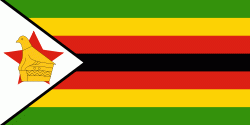Gokwe North District (Gokwe North District)
Gokwe North District is the northern of two administrative districts in the Gokwe region of the Midlands province of Zimbabwe. Its administrative seat is Nembudziya.
Chief Jahane, is one of the key notable traditional individual within the region. Copper Queen (Sanyati) mine is located in ward 22. Zenda mine is also found in ward 22. Matize school is located 11 km north east of Copper Queen mine.Matize is one of the most beautiful villages of ward 22.People started settling in the area soon after independence. The local VaShangwe came from within the district from places such as Chinyenyetu, Kuwirirana, Nyamazengwe and Mudzongwe. People of the Karanga dialect came mainly from Shurugwi, Chivi, Gutu, Chirimuhanzu,Mberengwa and Zvishavane. Matize village thrives on cattle products, cotton and maize farming. Recently gold mine claims have been pegged with artisanal miners (makorokoza/maShurugwi) cashing in on the precious metal. Matize village does not have a secondary school. The nearest secondary school is Kamhonde across Sanyati river in Makonde, Mashonaland West, this also applies to the nearest health center (Kamhonde clinic). Matize village falls under the jurisdiction of Headman Makore of the Shava totem. The paramount chief is Chireya also of the Shava totem. Geography of Matize village. The village is located in the Sanyati Valley. The latitude being 900m above sea level. The vegetation is dominated by Mopane, Mupfuti baobab,muvanga and mutondo trees. Matize is blessed with many streams which are tributaries of the Sanyati River. These includes Matize, Mapfuti,Bowapuwa and Nyahondo. Neighboring villages includes Mutukanyi, Mutivura, Ronga, Nyaurungwe and across Sanyati river Chirariro and Kamhonde in Mashonaland West.
Gokwe North District is found in ecological region 4, with arid and semi-arid conditions caused by the low average rainfall amounts of between 250 mm per year -800 mm per year. The temperatures range from 22-34 degrees Celsius(chiguye 2016). According to Brazer (2022), Gokwe district has many children out of school due to early marriage and pregnancy.Clean water shortages are very high with women and girls travelling long distances to fetch water from open sources, or queing for more than an hour at boreholes.It is very difficult to achieve SDG 4 in Gopkjwe doistrict considering the long distances between primary secondary and high schools in the district.
* Gokwe South District
* Gokwe centre
Chief Jahane, is one of the key notable traditional individual within the region. Copper Queen (Sanyati) mine is located in ward 22. Zenda mine is also found in ward 22. Matize school is located 11 km north east of Copper Queen mine.Matize is one of the most beautiful villages of ward 22.People started settling in the area soon after independence. The local VaShangwe came from within the district from places such as Chinyenyetu, Kuwirirana, Nyamazengwe and Mudzongwe. People of the Karanga dialect came mainly from Shurugwi, Chivi, Gutu, Chirimuhanzu,Mberengwa and Zvishavane. Matize village thrives on cattle products, cotton and maize farming. Recently gold mine claims have been pegged with artisanal miners (makorokoza/maShurugwi) cashing in on the precious metal. Matize village does not have a secondary school. The nearest secondary school is Kamhonde across Sanyati river in Makonde, Mashonaland West, this also applies to the nearest health center (Kamhonde clinic). Matize village falls under the jurisdiction of Headman Makore of the Shava totem. The paramount chief is Chireya also of the Shava totem. Geography of Matize village. The village is located in the Sanyati Valley. The latitude being 900m above sea level. The vegetation is dominated by Mopane, Mupfuti baobab,muvanga and mutondo trees. Matize is blessed with many streams which are tributaries of the Sanyati River. These includes Matize, Mapfuti,Bowapuwa and Nyahondo. Neighboring villages includes Mutukanyi, Mutivura, Ronga, Nyaurungwe and across Sanyati river Chirariro and Kamhonde in Mashonaland West.
Gokwe North District is found in ecological region 4, with arid and semi-arid conditions caused by the low average rainfall amounts of between 250 mm per year -800 mm per year. The temperatures range from 22-34 degrees Celsius(chiguye 2016). According to Brazer (2022), Gokwe district has many children out of school due to early marriage and pregnancy.Clean water shortages are very high with women and girls travelling long distances to fetch water from open sources, or queing for more than an hour at boreholes.It is very difficult to achieve SDG 4 in Gopkjwe doistrict considering the long distances between primary secondary and high schools in the district.
* Gokwe South District
* Gokwe centre
Map - Gokwe North District (Gokwe North District)
Map
Country - Zimbabwe
 |
 |
| Flag of Zimbabwe | |
The British South Africa Company of Cecil Rhodes demarcated the Rhodesia region in 1890 when they conquered Mashonaland and later in 1893 Matabeleland after a fierce resistance by Matabele people known as the First Matabele War. Company rule ended in 1923 with the establishment of Southern Rhodesia as a self-governing British colony. In 1965, the white minority government unilaterally declared independence as Rhodesia. The state endured international isolation and a 15-year guerrilla war with black nationalist forces; this culminated in a peace agreement that established universal enfranchisement and de jure sovereignty as Zimbabwe in April 1980. Zimbabwe then joined the Commonwealth of Nations, from which it was suspended in 2002 for breaches of international law by its government under Robert Mugabe and from which it withdrew in December 2003.
Currency / Language
| ISO | Currency | Symbol | Significant figures |
|---|---|---|---|
| ZWL | Zimbabwean dollar | 2 |
| ISO | Language |
|---|---|
| SN | Shona language |















